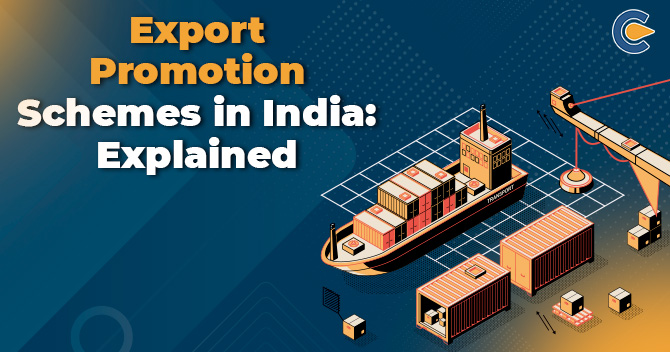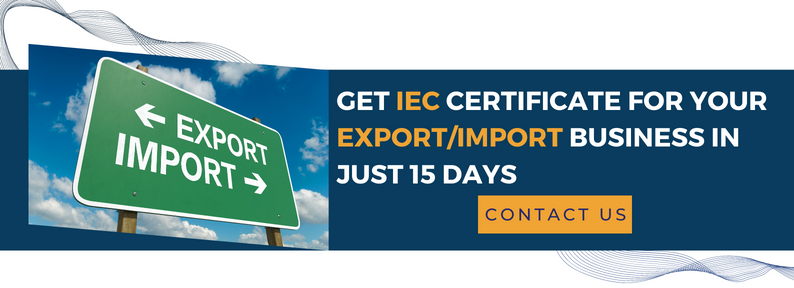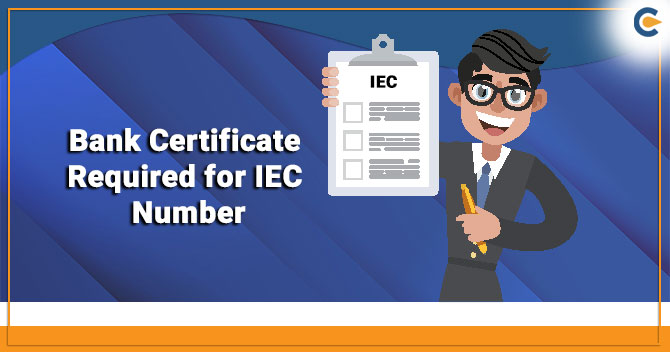As you know, export plays a significant role in the nation’s economic development. The increasing inward foreign remittance is beneficial for the nations as it helps in creating more jobs and keeps the nation in healthy financial state. Henceforth, India needs to improve its export capabilities through the introduction of various Export Promotion Schemes.
India is still a developing nation. China’s overall exports are nearly eight times that of India. Despite being one of the world’s largest nations, India barely secured 18th position in the list of top exporting nations globally in 2019. Even a small nation like Singapore has managed to outshine India with a considerable margin in the export department.
Why India’s export figures are not improving?
One of the prominent reasons for India’s sub-par export performance is its high cost of exportable commodities. India exporters are finding it tough to sell their offerings at acompetitive rate, which makes them uncompetitive in International markets resulting in loss of orders.
So why do Indian commodities do not have competitive prices? They could be many reasons for the same, and some of them are mentioned below:
Poor Infrastructure
This escalates the cost of operating business in India. For instance, it is affordable and seamless to move a consignment via ship from Hongkong to Kolkata; then it is to move the same from Chennai to Mumbai by road/rail.
Associated Costs
Rail freight rates for the Export sector are on the higher side as compared to other nations. Besides, Industrial electricity rates in our nation are quite steep. The high cost of land for establishing production units is another key factor leading to an increase in prices.
Cost of credit
Owing to high inflation, the rate of interest in India has remained on the higher side for a very long duration.
All the aforesaid factors lead to a rise in the cost of export items as compared to other nations. Henceforth, the GOI strives to compensate for the downsides that the exporters encounter by implementing various Export Promotion Schemes/Export Incentives in India.
Therefore for better export pricing and to stay competitive in the international market, it is become vitally important to have a complete understanding of such schemes.
Key Export Promotion Schemes in India for Exporters
The following section shall cover all the primary export schemes in detail. The benefit under more than one scheme can be taken for a given consignment with some exceptions. So go through all the schemes and examine your eligibility to access export incentives in India.
Merchandise Exports from India Scheme (MEIS Scheme)
The objective of this Export Promotion Scheme is to encourage the producer and export of notified products/goods from India.
- Funds Allocated – 40,000 Cr. Annually (Approx)
- Under the said scheme, an incentive of 2 to 5 per cent of the FOB value of exports is provided to exporters and manufacturer cum exporters regardless of their yearly turnover.
- The export of items notified in Appendix 3B only have access to MEIS benefits.
- There are over 8000 items/products that fall under this scheme
- There is no limitation of the nation. i.e. eligible items shipped to any nation can access the MEIS scheme.
- MEIS rate of incentives varies product-wise.
- Application relating to MEIS scheme is to file digitally to the respective DGFT office
- MEIS incentives are not provided in the form of bank transfers or cash. It is available in the form of duty credit scrip, also called MEIS licenses. These licenses can be utilised for payment of import-related duties or can be sold in the open marketplace at a discounted rate.
- MEIS is soon to be replaced with the new RoDTEP Scheme. However, shipments till December 2020 or March 2021 can still claim MEIS benefits.
Rebate of Taxes and Duties on Export items (RoDTEP Scheme)
- The new RoDTEP Scheme serves as a replacement for MEIS Scheme, which came into effect in December 2020.
- RoDTEP Scheme[1] was launched because the former scheme was not WTO-compliant and it didn’t comply with the international trade rules.
- This Export Promotion Scheme seeks to remit all those undercover taxes and levies, which was otherwise not available under any schemes, for example:
- State and Central taxes on fuel utilised for shipment of exportable products.
- The duty imposed by the state on electricity utilised for production
- Mandi tax imposed by APMCs.
- Stamp duty and toll tax on the shipping documents
- Toll tax & stamp duty on the import-export documentation.
Service Export from India Scheme (SEIS Scheme)
- Service Exports from India Scheme aims to advocate and strengthen export of notified services from India.
- Service exports also facilitate the massive foreign exchange to the nation, henceforth, the motivation of the service exporters is vital, and it is the need for an hour.
- Under this scheme, an incentive of 3 to 7 per cent of net foreign exchange earnings is facilitated to service exporters.
- This Export Promotion Scheme seeks service providers to have a valid IEC code with minimum net foreign exchange earnings amounting to 15,000 USD to be eligible under the scheme.
- Services mentioned in Appendix 3D are only eligible to access the rewards.
- Just like the MEIS scheme, rewards under this scheme are facilitated in the form of duty credit scrips.
- An application under this scheme is to be filed digitally to the respective DGFT office
Advance Authorisation Scheme (AAS)
- Advance License scheme came into effect to ensure duty-free import of raw materials required for the production of exportable items
- It indicates that no import shall be imposed on the import of raw material if it is used for the production of exportable items.
- An Advance license can be granted for deemed exports (For supply to any AA/EPCG holder or Ex. Supply to EOU units) and physical exports (including supply to SEZ).
- Advance License comes with a requirement of maintaining at least 15 per cent value addition and export the items within 18 months from the date of the issuance of the license.
- The materials imported under this scheme come with “Actual User condition”-meaning they cannot be sold or transferred to any third party.
- This Export Promotion Scheme is introduced by the Directorate General of Foreign Trade
Duty-free Import Authorisation (DFIA Scheme)
- The aim of this scheme is to facilitate duty-free import of raw material. But, unlike AA, this scheme refers to a post-export scheme. It implies that duty-free import is permissible only after the export is made.
- DFIA scheme covers only those items which are listed under Standard Input-Output Norms (SION).
- Another key feature of this scheme is that it is transferable in nature. However, the condition relating to the actual user condition doesn’t apply here.
- Just like the Advance Authorisation Scheme, the DFIA scheme is launched by the DGFT.
Duty Drawback Scheme (DBK Scheme)
- DBK scheme proposes refund of the duties encountered by the exporter during shipment. The scheme was launched and probed by the Department of Revenue [Customs Department].
- Under this scheme, duties of central excise and customs authority that are chargeable on imported and domestic material utilised in the production of exportable items are refunded back.
- The duty drawback rate differs product-wise. One can locate the entire Duty Drawback schedule on the CBIC’s portal.
- Unlike other schemes, the amount under this scheme is directly credited into the exporter’s bank account within two months from the date of shipment.
- If you are accessing the GST refund, then you should choose a lower rate of the Duty Drawback.
- DBK can be integrated with any other schemes as mentioned, but it cannot be integrated with the DFIA Scheme or Advance Authorisation scheme
RoSCTL Scheme: Rebate on State and Central Taxes and Levies
- The new RoSCTL Scheme was introduced by GOI as a replacement for its predecessor on 07.03.2019.
- RoSCTL scheme only covers Apparels & made-up Industries encompassing Chapters 61, 62 & 63 of ITC (HS).
- This Export Promotion Scheme facilitated a refund of Central and State taxes and levied like VAT on fuel, Mandi tax, Captive power, Electricity Duty, etc.
- Directorate General of Foreign Trade implemented this scheme for rewarding exporters via duty credit scrips.
Export Promotion Capital Goods Scheme (EPCG Scheme)
- The aim of this Export Promotion Scheme is to provide the import of capital goods/machinery for manufacturing goods and improve India’s manufacturing competitiveness.
- Under the EPCG Scheme, Manufacturer cum exporter or a merchant exporter connected with a supporting manufacturer can import capital goods/equipment required for Pre-production, production and post-production of exportable items at zero per cent duty
- Application to secure an EPCG License should be made to the respective DGFT office.
- The Service exporters earning in overseas currencies can also apply for an EPCG license. Various service exporters can leverage this scheme to minimise capital costs. Service Exporters like Tour and travel operators, hotels, logistics facilities, construction entities can use this scheme by importing capital goods/machinery at zero per cent duty.
- EPCG schemes underpin some export obligations. The import of capital goods under this scheme is subject to an export obligation which is equivalent to six times of duty saved, to be fulfilled within six years from the date of issuance of EPCG authorisation.
EOU/EHTP/STP/BTP Schemes
- EOU Scheme [Export-oriented Units] is accessible to units that are only engaged with exporting activities.
- This scheme came to effect in 1981, and it aims at increasing export activities in the country.
- The EOU schemes intend to facilitate a viable framework to the companies involved with 100 per cent exports by rendering them certain waivers and concessions in compliance and tax-related matters, thereby making it seamless for them to operate a business.
- The primary benefits of this scheme include; Nil import duties for the procurement of raw materials or capital goods, swift custom clearance, etc.
- An application has to be filed with the Board of approval to establish an EOU unit.
- The minimum investment in production facility and machinery required is 1 Cr with exemptions to certain sectors.
- Around 2011-12, the EOU scheme turned out less effective owing to the unavailability of tax benefits under the IT Act.
GST Refund for Exporters / LUT Bond / 0.1% GST benefit for Merchant Exporters.
- Exporters have facilitated an array of preferential facilities as per the GST Act.
- The LUT facility under GST enables exporters to skip GST payment in the pre-shipment phase. For this purpose, the exporters need to secure a letter of undertaking/bond.
- Exporters can prompt customs for reemitting claim refund on IGST paid for the shipment.
- Merchant exporters/traders can procure exportable goods from domestic suppliers at a concessional GST rate of 0.1%. This minimizes the burden of GST and resolves problems relating to working capital to a great extent.
Transport and Marketing Assistance Scheme (TMA Scheme)
- This Export Promotion Scheme was introduced on 01.03.2019, and it covers agricultural export products only.
- Under this scheme, the GOI subsidises the freight cost to make Indian agricultural items competitive in the international market.
- The TMA scheme covers export products cited under chapters 1 to 24 of the ITC HS code, including plantation and marine products. But, some specific products enlisted under Chapters 1 to 24 would not be encompassed under the scheme for assistance
- Assistance under this scheme shall be facilitated in cash via a bank transfer as a part of subsidisation of freight cost addressed by the exporter.
- DGFT is the prime authority that has launched this scheme.
Deemed Export Benefits
The objective of deemed export benefits is to inculcate the transparent and unprejudiced environment for the domestic manufacturers in certain specified scenarios, as may be directed by the GOI from time to time.
Given supplies are deemed as Deemed Exports –
- Supply of items against Advance Authorisation (AA) / Advance Authorisation for annual requirement /DFIA;
- Supply of items to EOU/ EHTP/ STP /BTP Units;
- Supply of capital goods against EPCG License.
Common benefits available to Deemed Export supplies include;
- Advance Authorisation/DFIA;
- Refund of terminal excise duty.
- Deemed Export Duty Drawback;
Market Access Initiative (MAI Scheme)
- Market Access Initiative (MAI Scheme) rolled out by the GOI on 16th February 2018.
- This Export Promotion Scheme aims to play a proactive role in encouraging export from India by pinpointing new markets and supporting the export promotion undertakings in the new markets.
- The scope of the scheme is to facilitate financial aid to eligible departments for executing undertakings like market research, direct/indirect marketing, and promotion & branding in new markets, handling statutory compliance costs in the importing nation.
- The eligible department includes all the Commodity Boards, Export Promotion Councils, certified trade promotion agencies, recognised associations, individual exporters, reputed institutions like IITs, IIM’s, etc.
How does the MAI scheme benefit Individual Exporters?
- MAI scheme benefits individual exporters in two different ways. To avail of such benefits, the Individual exporters need to contact the respective EPC.
- Reimbursement of Airfare for Global Events – Maximum of Rs. 70,000/- (Individual ceiling) (Rs.1lakhs for LAC nations). However, such benefit is only accessible to exporters having annual turnover below 30 cr in the preceding FY. Also, the exporter should be the EPC’s members for at least one year to become eligible for this benefit.
- Statutory compliances in the buyer nation- Maximum ceiling of Rs, 50, 00,000/annum per exporter on a 50-50% sharing basis. Statutory compliance entails Registration charges paid in the importing nation in the case of biotechnology, pharma, chemicals/ agrochemicals, animal/marine products, etc.
Market Development Assistance (MDA) Scheme
- This is an erstwhile Export Promotion Scheme that was clubbed into new Market Access Initiative, 2018
- The new scheme encompasses the scope of both the previous MAI scheme and the Market Development Assistance scheme.
Towns of Export Excellence (TEE)
- The overall export valuation of town goods is more than Rs 750 Cr. And owing to high export potential, these goods are tagged as Towns of export excellence (TEE).
- Fiscal support is facilitated to recognised facilities in those towns as per the norms cited under MAI Scheme
- According to Appendix 1B, there are 37 towns of export excellence pan India.
- TEE aims to indirectly benefit the Individual exporters
Interest Equalisation Scheme (IES)
- IES (aka Interest subvention scheme) came to effect in April 2015. This scheme aims to facilitate pre and post-shipment export credit in domestic currency.
- The scheme facilitates 5 per cent interest support to MSME industries and 3 per cent support to all exporters in respect of the identified 416 tariff lines.
- This scheme is introduced and regulated by the Reserve Bank and other designated banks.
- Banks pass on the benefit of lower interest to the exporters and then claim a reimbursement from the Reserve bank.
NIRVIK Scheme
- The Export Credit Guarantee Corporation of India rolled out the NIRVIK scheme to facilitate higher insurance cover, lower premiums for small exporters, and a user-friendly claim settlement process.
- It typically serves as an insurance cover guarantee scheme that renders a coverage up to 90 per cent of principal and interest as against the prevailing credit guarantee of only up to 60 per cent loss. The cover shall encompass the pre and post-shipment export credit.
- This scheme shall ensure that the overseas and rupee credit interest rate shall remain below 4 per cent and 8 per cent, respectively.
- This scheme is launched by ECGC Ltd, a wholly-owned department of the Ministry of Commerce and Industry.
Conclusion
An availability of proper credit schemes has prevented Indian exports to touch its real potential for years. GOI launched these Export Promotion Schemes to patch export loopholes by incentivizing exporters.
Read our Article:Duty Credit Scrips for Indian Exporters: Explained













